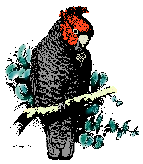Noisy Miner Manorina melanocephala
This species is known to be successful at becoming dominant at disturbed
sites. It has a strong social system and colonies will establish at particular
sites and tend to exclude other species. It is a conspicuous and bold species.
Some sites have many repeat observations of similar sized groups lasting over
several weeks or many years and others have just a few observations of small
numbers of them. At 0.2% of total birds, it is not a major part of Canberra?s
suburban avifauna. The monthly pattern has changed. In the first about eight
years, seasonal fluctuations were marked. With a minimum in September, numbers
climbed fairly smoothly to a May peak then declined again. Since then this
variation has reduced dramatically. When all years' results are pooled, that
monthly trend still shows but is not strong. The same happened with the Red
Wattlebird and for probably the same reasons, although this species is on about
one tenth abundance scale. After high numbers in the first two years, the
long-term abundance has fluctuated. .........Graphs on page: 98, Rank: 64,
Breeding Rank: 37, A = 0.15932, F = 19.00%,
W = 50.0, R = 4.603%, G = 3.46.
End of GBS Report extract
"Do we have species that control the avian diversity in urban areas? ?
Evidence for Noisy Miners and Common Mynas.
Kris French
Institute for Conservation Ecology, University of Wollongong
There is a great deal of discussion amongst councils and the
community about how our conservation dollar should be spent in cities to
conserve our wildlife. More recently there has been a push by some groups to
spend dollars controlling Common Mynas that they consider to be one of the
causes of loss of birds in cities. How do governments weigh up these various
viewpoints to achieve good conservation outcomes for their communities?
What evidence can science add to the debate?
The Common or Indian Myna is considered a pest species
in many parts of the world because it damages fruit and grain crops and their
noise and smell can be annoying where they are in large numbers. They are street
wise and cheeky, becoming fearless of people and interfering in picnics etc.
They are considered to be a problem for biodiversity because they nest in
hollows which are in short supply due to agricultural clearing. In a study in
Canberra, they fought for nest hollows with two species of parrot. In the BIBY
Survey we found that Common mynas occurred in 80% of gardens. However, parrots
also occurred commonly, suggesting that that they may not be a problem for
parrots in these coastal cities. Furthermore, the Birds in Backyards survey
found that none of the seven small birds surveyed were negatively related to the
presence of Common mynas.
Noisy Miners are a native cooperatively breeding species
that has colonies of individuals that rigorously defend feeding territories from
all species of birds. It traditionally occupied open grassy woodland. Research
in agricultural remnants in Victoria has found that there is an increase in
species richness in remnants following removal of Noisy Miners. There are also
studies along roadsides in the Southern Highlands and in the Wimmera,
documenting negative relationships between noisy miners and species richness. We
have also found a similar pattern occurring in cities in both remnants (Wyong
study) and in the streets (Illawarra study). Noisy miners overlap with many
small birds in terms of both foraging and nesting requirements so it is not
surprising that the BIBY survey found a strong significant negative relationship
between the presence of small birds in gardens and the presence of Noisy
Miners.
We have some good evidence that one of the most important
influences determining which birds occur in urban areas is the presence of noisy
miners. We have yet to prove that spending conservation dollars on removing or
controlling these birds is worthwhile. We must weigh up their native status and
the expense of catching and removing them ?and we need to know if it will work.
We must weight up other measures such as changing our gardens. However, I think
it is time that we undertook the main test. We need a trial removal from some
suburbs to see if we can encourage small birds back again.
I don?t think there is the evidence to spend money on Common
Mynas. Spend aesthetic dollars or even health dollars if evidence is gained. But
let?s stop picking on the non-native, just because it is abundant!!"
End of quote
Philip

